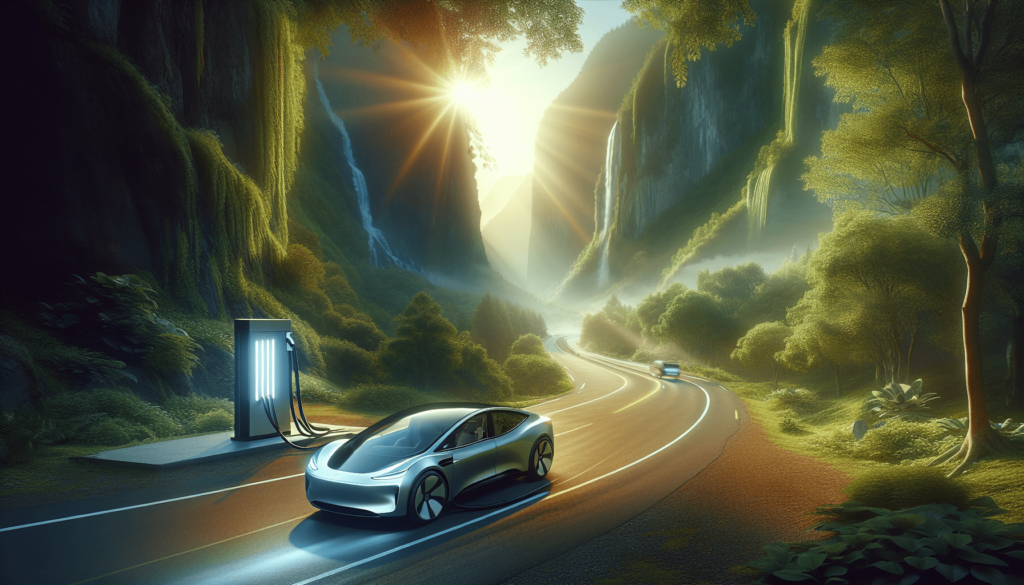Taking an Electric Vehicle on a Road Trip
Share

So, you’re interested in embarking on a road trip with an electric vehicle (EV), huh? Well, let me assure you, it’s not only possible, but it can also be an exhilarating adventure! Sure, there may be a few considerations and planning involved, but with the increasing availability of charging stations and the continual improvement of EV technology, hitting the open road in an electric vehicle is becoming more convenient and exciting than ever. In this article, we will explore the ins and outs of taking an EV on a road trip, providing you with all the tips and tricks you need to make your voyage smooth and memorable.
Planning the Road Trip
Determining the Route and Destinations
When planning a road trip with an electric vehicle (EV), it is important to consider the route and destinations. Start by selecting the desired locations you wish to visit along the way. Take into account the distance between each destination and the availability of charging stations in those areas. Mapping out a route that provides convenient access to charging infrastructure will ensure a smoother and more enjoyable journey.
Identifying Charging Stations along the Route
To successfully complete a road trip in an EV, it is crucial to identify and plan for charging stations along the route. Utilize online resources, such as charging station locator apps or websites, to find charging points in the areas you will be traveling through. Consider the types of chargers available, including fast chargers, standard chargers, and those compatible with your vehicle. This information will help you strategize your charging stops and estimate the charging time required at each station.
Calculating Charging Time and Range
Understanding the charging time and range of your EV is essential for effective trip planning. Take note of your vehicle’s battery capacity and charging rates. Calculate the average charging time needed based on the charger type and battery percentage when you arrive at each charging station. Additionally, consider the range of your EV and estimate how far you can comfortably travel between charging stops. These calculations will give you a clear idea of how to manage your charging schedule and ensure you have enough range to reach your destination.
Mapping Rest Stops and Breaks
While planning a road trip with an EV, it is essential to consider not only charging stops but also rest stops and breaks. Long drives can be tiring, and taking regular breaks is crucial for driver safety and comfort. Incorporate rest stops into your itinerary and identify areas where you can stretch your legs, grab a meal, or enjoy some sightseeing. By planning these breaks, you can recharge yourself while your EV recharges as well.
Preparing the Electric Vehicle
Checking the Vehicle’s Battery Health and Range
Before embarking on a road trip with an EV, it is important to check the battery health and range of the vehicle. Ensure that the battery is in good condition, as this will affect the overall range and performance of the vehicle. Consult your vehicle’s manual or contact the manufacturer for guidance on checking battery health. Additionally, monitor the estimated range provided by your EV’s onboard system and use it as a reference when planning your charging stops.
Inspecting and Maintaining Tires
Tire maintenance is crucial for any road trip, and it becomes even more important when traveling with an EV. Check the tire pressure regularly to ensure optimal efficiency and range. Properly inflated tires contribute to improved energy efficiency, which is crucial for maximizing your EV’s range. Additionally, inspect the tire tread depth and overall condition to ensure safe and reliable performance during your trip.
Bringing Necessary Charging Cables and Adapters
To be prepared for any charging situation, it is advisable to bring along necessary charging cables and adapters. While most charging stations provide standard charging cables, having your own set ensures compatibility and convenience. Consider the charging connectors used by various charging stations and make sure you have the corresponding adapters. This will help you avoid any inconvenience or delays in charging your EV during the trip.
Packaging Emergency Toolkit
No road trip is complete without a well-prepared emergency toolkit, and the same holds true for EV road trips. Pack a toolkit with essential items such as a tire repair kit, flashlight, jumper cables, and a first aid kit. Additionally, consider including spare EV-specific items like fuses and cables. Being prepared for any unforeseen circumstances will give you peace of mind during your journey.

Understanding Charging Infrastructure
Types of Charging Stations
Before heading out on a road trip with your EV, it is important to understand the different types of charging stations available. The three main types of charging stations are Level 1, Level 2, and DC fast chargers. Level 1 chargers are the slowest, typically found at homes, and use a standard wall outlet. Level 2 chargers provide faster charging and are commonly found in public areas such as parking lots or workplaces. DC fast chargers offer the fastest charging speeds and are typically located along major highways or at dedicated charging stations.
Fast Charging versus Standard Charging
When planning your charging stops, it is essential to consider whether to utilize fast charging or stick with standard charging. Fast chargers provide a significant amount of charge in a short amount of time, but they can be more expensive and may have limited availability, especially in remote areas. On the other hand, standard chargers offer slower charging speeds but are more widely available. Consider your itinerary, the availability of fast chargers along your route, and the time you have to spare at charging stations when deciding between the two options.
Utilizing Public and Private Charging Networks
Public charging networks play a crucial role in enabling EV road trips by providing access to charging infrastructure. Many charging networks offer membership plans that provide benefits such as discounted charging rates and access to network-specific charging stations. Research the public charging networks available in the areas you will be traveling through and consider signing up for memberships that align with your needs. Additionally, some private locations like hotels or shopping centers may have their own charging stations, which can be beneficial to utilize during your road trip.
Wireless Charging Technology
Wireless charging technology for EVs is an emerging trend that offers convenience and ease of use. With wireless charging, charging pads or plates are embedded in the ground, and the EV’s charging receiver is integrated into the vehicle. This eliminates the need for physical cables and connectors, simplifying the charging process. While wireless charging infrastructure is still limited compared to traditional charging stations, it is worth exploring if any wireless charging options are available along your route, as it provides a hassle-free charging experience.
Maximizing Efficiency and Range
Driving Techniques for Range Optimization
To maximize the efficiency and range of your EV during a road trip, it is important to adopt certain driving techniques. Smooth and gradual acceleration, maintaining a steady speed, and avoiding unnecessary braking are key practices for conserving energy. Additionally, planning your routes to take advantage of downhill stretches and avoiding excessive use of high-speed highways can significantly contribute to range optimization. By being mindful of your driving habits, you can ensure that you get the most out of each charge.
Managing Climate Control and Auxiliary Features
Climate control systems and auxiliary features such as heated seats or entertainment systems can impact your EV’s range. Using these features extensively can drain the battery more quickly. To maximize range, consider adjusting the climate control settings to optimize energy efficiency. Pre-conditioning your EV while it is still connected to a charger can ensure a comfortable interior temperature without relying on battery power. Utilize these features judiciously during your road trip to strike a balance between comfort and range preservation.
Utilizing Regenerative Braking
One unique feature of EVs is regenerative braking, which converts the kinetic energy produced while braking back into electrical energy to recharge the battery. This helps to extend the vehicle’s range by reducing the reliance on the charging infrastructure. Take advantage of regenerative braking by driving smoothly and anticipating stops ahead, allowing the vehicle to automatically engage regenerative braking when you lift your foot off the accelerator. By harnessing this energy, you can add a few extra miles to your range without consuming additional charging time.
Minimizing Energy Consumption for Electronic Devices
While on a road trip, it is common to use electronic devices such as smartphones or tablets for navigation or entertainment. However, it is important to minimize their energy consumption to preserve your EV’s range. Prioritize charging these devices while the vehicle is connected to a charger during your breaks. Additionally, consider using battery-saving modes on your devices, dimming the screens, and closing unnecessary apps to minimize energy usage. These small actions can add up and help extend your EV’s range during the trip.

Finding Accommodation with Charging Facilities
Researching EV-friendly Hotels and Lodgings
When planning a road trip with an EV, it is essential to consider accommodation options that provide charging facilities. Research EV-friendly hotels and lodgings along your route to ensure you will have access to charging stations overnight. Look for accommodations that specifically mention EV charging or have designated EV parking spots. Prioritize hotels with Level 2 or fast charging options, depending on your needs and the approximate time you will be spending at each location.
Ensuring Availability and Compatibility of Charging Stations
While researching accommodation options, it is important to ensure the availability and compatibility of charging stations at the chosen hotels or lodgings. Check if the charging stations are open to the public or exclusive to hotel guests. Additionally, confirm that the chargers are compatible with your EV’s charging connector type. This information will help you plan your charging stops effectively and avoid any inconvenience or surprises when reaching your accommodation.
Booking Accommodations in Advance
To guarantee a seamless road trip experience, it is advisable to book accommodations in advance. EV-friendly hotels and lodgings with charging facilities may have limited availability, especially during peak travel seasons. By booking ahead, you can secure a spot and avoid last-minute complications. Be sure to communicate your need for charging facilities to the hotel during the booking process to ensure they can accommodate your requirements.
Considering Alternative Accommodation Options
In some cases, finding accommodation with charging facilities may be challenging, especially in remote areas or less EV-friendly regions. In such situations, consider alternative accommodation options. Look for campsites, RV parks, or even private rentals that offer charging options. These alternatives may require a different level of planning and preparation, but they can provide a viable solution when traditional hotels or lodgings are not readily available.
Enjoying the Road Trip Experience
Exploring EV-specific Sightseeing and Attractions
One of the joys of a road trip is exploring new places, and EV-specific attractions can add an extra layer of excitement to your journey. Discover destinations that focus on eco-friendly transportation or showcase innovative EV technology. Museums, exhibitions, or even EV manufacturing facilities may offer unique insights into the world of electric mobility. Including these stops in your itinerary not only adds to the overall road trip experience but also offers opportunities to learn and engage with the EV community.
Engaging with Local EV Communities
As electric vehicles become more popular, local EV communities have emerged worldwide. Take advantage of these communities to enhance your road trip experience. Engage with EV owners in the areas you will be traveling through by joining online forums or social media groups. Connect with local EV enthusiasts, ask for recommendations, and share your planned itinerary. The insights and experiences shared by the community can provide valuable information, making your journey more enjoyable and memorable.
Documenting the Journey and Sharing Experiences
Documenting your road trip with an EV can create lasting memories and inspire others to embark on similar adventures. Capture photos, videos, or even journal entries throughout the trip to chronicle your experiences. Share your journey on social media or through blog posts to inspire fellow EV enthusiasts and showcase the feasibility of road trips in electric vehicles. Celebrating your experiences not only adds value to your own journey but also contributes to the larger EV community.
Embracing the Benefits of Quieter and Cleaner Travel
One of the distinct advantages of traveling in an EV is the quieter and cleaner experience it offers. Electric vehicles produce significantly less noise pollution compared to traditional combustion engine vehicles, creating a serene and peaceful atmosphere during your road trip. Additionally, EVs produce no tailpipe emissions, contributing to cleaner and more sustainable travel. Embrace and appreciate these benefits as you embark on your road trip, recognizing the positive impact you are making on the environment.

Dealing with Range Anxiety
Understanding Range Anxiety and Its Causes
Range anxiety refers to the fear or concern of running out of battery charge before reaching a destination or the next charging station. It is a common concern for EV owners, especially when venturing on long road trips. Range anxiety is primarily caused by a lack of familiarity with an EV’s range capabilities, concerns about the availability of charging infrastructure, and uncertainties about how driving habits impact range. By understanding the causes of range anxiety, you can better address and overcome it during your road trip.
Strategies for Overcoming Range Anxiety
To overcome range anxiety during a road trip, it is important to plan and strategize effectively. Follow the recommendations outlined earlier regarding route planning, identifying charging stations, and managing driving techniques. Familiarize yourself with your EV’s range limitations and charging requirements. By ensuring you have a clear plan and understanding of where and when to charge, you can alleviate range anxiety and confidently embark on your journey.
Identifying Backup Charging Options
Having backup charging options is crucial to mitigating range anxiety during a road trip. When mapping out your route, identify alternative charging stations or backup options in case your intended charging points are occupied or out of order. Note nearby charging stations or facilities along your route that can serve as alternatives. By having a contingency plan in place, you can avoid unnecessary stress and anxiety if unforeseen circumstances arise.
Collaborating with Other EV Owners for Assistance
The EV community is known for its supportive and collaborative nature. If you encounter any issues or range anxiety during your road trip, don’t hesitate to reach out for assistance. Connect with other EV owners along your route or through online forums and seek advice or guidance. You may find fellow EV enthusiasts who can offer assistance, recommendations, or even share their charging stations if needed. Collaborating with other EV owners can provide a sense of community and support, making your road trip more enjoyable.
Emergency Situations and Contingency Plans
Handling Unexpected Breakdowns or Repairs
While EVs are generally reliable vehicles, unexpected breakdowns or repairs can still occur. It is essential to be prepared for such situations during your road trip. Familiarize yourself with your EV’s specific breakdown procedures and emergency contact numbers. Know how to safely handle incidents such as a flat tire, mechanical issues, or accidents. In the event of a breakdown, follow the guidance provided by your vehicle’s manufacturer and utilize roadside assistance services when necessary.
Utilizing Roadside Assistance Services for EVs
Roadside assistance services specifically tailored for EVs are available and can be a valuable resource during a road trip. These services are designed to assist with EV-specific issues, such as charging problems, battery concerns, or towing. Research and identify reputable roadside assistance providers that offer coverage in the areas you will be traveling through. Keep their contact information readily accessible for quick and efficient assistance in case of emergencies.
Having Backup Transportation Options
In the event of a major breakdown or an extended repair period, it is essential to have backup transportation options available. Consider renting a traditional vehicle or utilizing rideshare services as contingency plans. Research car rental agencies in the areas you will be traveling through and ensure they have EV-friendly options if needed. Having a backup transportation plan in place will give you peace of mind and prevent any major disruptions to your road trip.
Carrying Emergency Supplies and Communication Devices
To ensure your safety during emergencies, it is important to carry emergency supplies and communication devices. Pack a roadside emergency kit that includes items such as reflector triangles, a flashlight, a basic toolset, and a fire extinguisher. Additionally, have a fully charged mobile phone with you at all times for effective communication. Consider investing in a dedicated GPS device or having offline maps available as a backup navigation method. These preparations will enable you to handle unexpected situations and maintain a level of connectivity during your road trip.

Legal and Safety Considerations
Familiarizing with Traffic Laws and Regulations
When embarking on a road trip with an EV, it is essential to be familiar with the traffic laws and regulations specific to the regions you will be traveling through. Laws relating to EVs, charging infrastructure, and parking may vary between jurisdictions. Research and understand the applicable regulations to ensure compliance and avoid any legal issues during your journey. This includes knowing the specifics of EV-specific parking privileges and restrictions to fully utilize available charging stations.
Implementing Safe Driving Practices for EVs
Safe driving practices are paramount during any road trip, regardless of the vehicle type. However, certain considerations apply specifically to EVs. Be aware of your EV’s size and weight, as it may differ from traditional vehicles. Pay attention to the increased acceleration capabilities of EVs to avoid abrupt maneuvers that could startle others on the road. Additionally, be mindful of pedestrians and cyclists, as EVs produce less noise, making them less noticeable. By implementing safe driving practices, you can ensure a smooth and secure road trip experience.
Obtaining Appropriate Insurance Coverage
When taking an EV on a road trip, it is crucial to review your insurance coverage and ensure it is appropriate for the journey. Confirm that your existing insurance policy adequately covers EV-related risks and consider additional coverage options if necessary. Some insurance providers offer specialized EV insurance, which may provide benefits such as coverage for charging cables or reimbursement for charging at public stations. Review your policy terms and consult with your insurance provider to make any necessary adjustments before setting off on your road trip.
Knowing EV-specific Safety Procedures
In addition to general safety considerations, familiarize yourself with EV-specific safety procedures. Understand where the emergency shut-off or disconnect points are on your EV in case of an accident or electrical hazard. Review the instructions provided by the vehicle manufacturer on how to handle emergency situations involving high-voltage systems. By knowing these procedures in advance, you can react appropriately in case of any EV-specific safety concerns that may arise during your road trip.
Returning Home and Reflecting on the Trip
Analyzing the Overall Road Trip Experience
Upon returning home from your road trip, take the time to analyze the overall experience. Reflect on the destinations visited, the charging infrastructure encountered, and the efficiency and range of your EV. Evaluate the success of your planning and preparations, identifying any areas for improvement. Consider the driving experience, the practicality of charging stops, and the enjoyment of the road trip as a whole. By analyzing the experience, you can enhance future road trips with your EV and share valuable insights with the EV community.
Reviewing the Effectiveness of Planning and Preparations
Evaluate the effectiveness of your planning and preparations for the road trip with your EV. Assess whether the chosen route and charging stops were optimal or if any adjustments can be made for future trips. Reflect on the usefulness of the resources used, such as charging apps or online communities. Consider whether you brought the necessary charging cables and adapters, emergency supplies, and backup transportation options. By reviewing the effectiveness of your planning and preparations, you can refine your approach and be better prepared for future EV road trips.
Evaluating the Performance and Reliability of the Electric Vehicle
Consider the performance and reliability of your electric vehicle during the road trip. Evaluate the battery range, charging time, and overall driving experience. Note any unexpected issues or limitations encountered and assess how they may impact future road trips. Reflect on the convenience and functionality of the charging infrastructure used and determine if any improvements can be made to enhance the EV ownership experience. Share your feedback with the EV manufacturer or community to contribute to ongoing improvements in EV technology and infrastructure.
Sharing Feedback and Recommendations with EV Community
To contribute to the continuous improvement of the EV community, share your feedback and recommendations with other EV owners. Document your road trip experience and share it through online forums, social media, or dedicated EV communities. Provide insights into the charging infrastructure, EV-friendly accommodations, or unique attractions you discovered. Your feedback can help other EV enthusiasts plan their own road trips and navigate potential challenges. By sharing your experiences, you can make a meaningful contribution to the growing EV community.
Taking an EV on a road trip is an exciting and rewarding experience. By carefully planning the route, preparing the vehicle, understanding the charging infrastructure, maximizing efficiency, and considering accommodation options, you can ensure a smooth and enjoyable journey. Embrace the unique benefits of EV travel, engage with the EV community, and overcome any range anxiety with confidence. With the right preparations and mindset, your EV road trip will not only be a testament to the viability of electric travel but also a memorable adventure filled with new experiences and connections.




